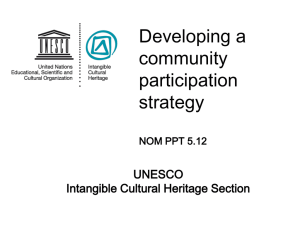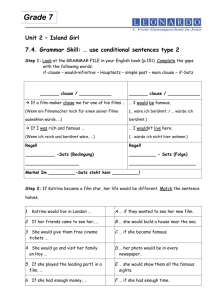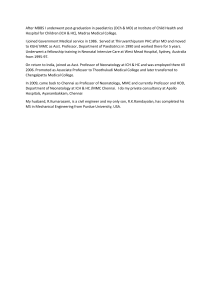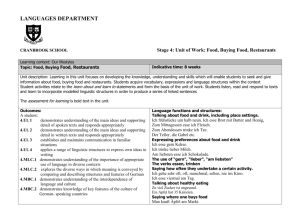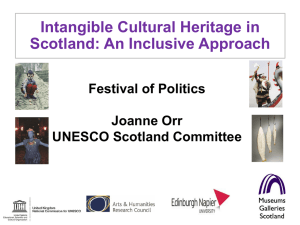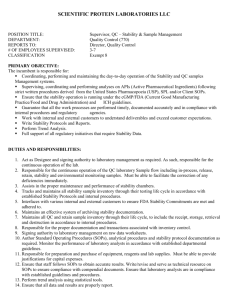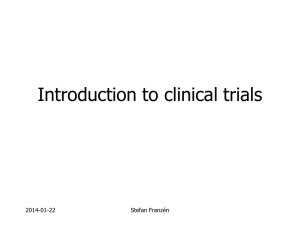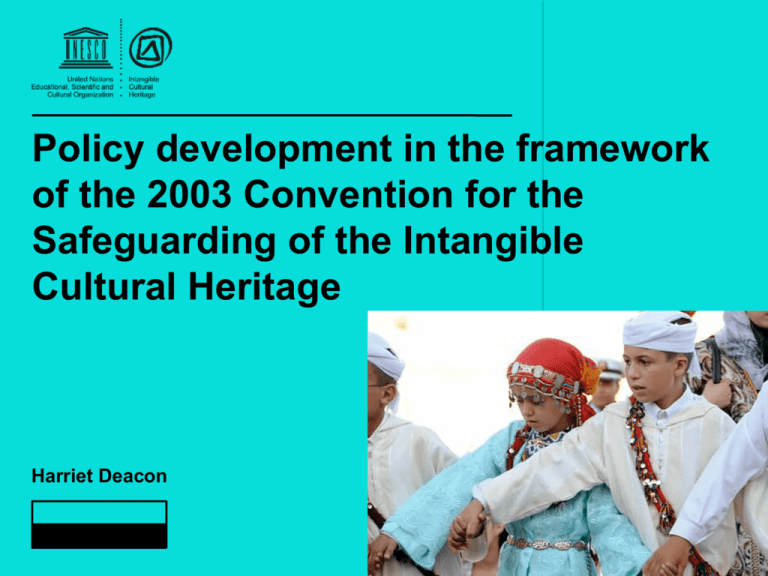
Policy development in the framework
of the 2003 Convention for the
Safeguarding of the Intangible
Cultural Heritage
Harriet Deacon
2
© All Rights Reserved: UNESCO/ ICH
1
• Request by State Party
• Needs assessment
2
• Consultations
• Policy workshop(s)
3
• Policy development process
• Implementation / revision
Overview
ICH policy making under the Convention
Experiences so far
Policy challenges and opportunities
Policy development processes
3
Drawing on: Guidance Note and underlying reports; Smeets, R. ‘Policy making for ICH safeguarding‘, Presentation at
UNESCO ICH meeting, Shenzhen Jan 2014
© All Rights Reserved: UNESCO/ ICH
Policymaking
under the
Convention
4
© All Rights Reserved: UNESCO/ ICH
Policymaking encouraged
Article 13
To ensure the safeguarding, development and
promotion of the ICH present in its territory, each
State Party shall endeavour to:
(a) adopt a general policy …
(d) adopt appropriate legal, technical,
administrative and financial measures …
5
An infrastructure for
safeguarding - I
• ICH-related policy, regulations and legislation (Article 13;
ODs 103–105);
• Bodies to assist in safeguarding with communities (Article
13(b-c); OD 109);
• Consultative bodies or coordination mechanisms with
community representation …(OD 80);
• Documentation centres for management and access to
information about the ICH (Article 13(d); OD 109);
6
An infrastructure for
safeguarding - II
• Building capacity for safeguarding (13(d)(i), 14, OD 82, 86,
107(k) and 109);
• Encouraging cooperation and networking between
communities, and between communities and other
stakeholders (ODs 79–80, 86 and 88);
• Financial measures (Article 13(d) and OD 78); and
• Sharing expertise and information internationally (Articles
1(d) and 19, ODs 86–88).
7
In the spirit of the Convention
Policy to support the safeguarding of ICH should
ideally …
• Promote recognition of diversity of ICH (Article 1,
Preamble),
• Promote community participation in ICH
safeguarding activities (Article 15, 11(b));
• Respect the principles of human rights, sustainable
development and mutual respect (Article 2.1); and
• Promote international cooperation and assistance
(Articles 19-20).
8
Where is the emphasis?
State encourages communities in their safeguarding
activities, and assists in creating a supporting
infrastructure
NGOs, research institutions and centres of expertise
play a supportive role
Emphasis on community involvement in identification
and safeguarding of their ICH
9
© All Rights Reserved: UNESCO/ ICH
Experiences so
far
10
National policy-making grows
• IOS evaluation: 75% of reporting States (29 out of 41 in 2011-13)
developed some kind of new ICH safeguarding policy
• UNESCO hosts a database of national cultural heritage laws, which
can be consulted for a broader range of ICH policies; 250 entries,
according to the database classification system, are ICH-related
laws. http://www.unesco.org/culture/natlaws/index.php
• The World Intellectual Property Organization (WIPO) maintains a
database of legislation that can be filtered for entries pertaining to
Traditional Cultural Expressions (1,018 entries) and Traditional
Knowledge (1,965 entries).
http://www.wipo.int/wipolex/en/results.jsp?countries=&cat_id=16
http://www.wipo.int/wipolex/en/results.jsp?countries=&cat_id=18
11
Diversity in approaches
• Specific ICH policies
• ICH policies integrated into overall culture policies
• Devolved policy arrangements for ICH
• New institutions or directorates responsible for ICH
• Broader mandates of existing institutions responsible for ICH
• Policies for specific ICH elements
• Living Human Treasures policies
• Provisions for specific communities and their ICH
12
Why this diversity?
• Regional and international influences;
• Approaches before ratification;
• Interpretations of the Convention;
• Reasons for ratifying the Convention; and
• Socio-political, historical and economic
contexts
13
Policy
challenges and
opportunities
14
Challenges and
opportunities
1. General context
2. Within the culture sector
3. Operational challenges
15
© All Rights Reserved: UNESCO/ ICH
1. General challenges and
opportunities
• New area for policy development; different reasons for
making ICH policy
• No detailed guidance on policymaking in the Convention
and its ODs - policymaking encouraged but not a binding
obligation
• Complexity of integration into existing policy agendas
• Different policy roles for ‘culture’ as concept
• Low political priority given to culture
16
Different policy goals
• Safeguarding ICH to benefit communities
• Development, tourism and innovation;
• Diversity and intercultural dialogue;
• Public participation and democracy;
• Social cohesion, nation-building and identity;
• International relations and cooperation;
• Recognition and protection of minorities or indigenous
groups
17
ALSO: claiming ownership over ICH nationally or
internationally, developing ‘national culture’, etc.
The global context: shifting
priorities
Enforcing common IPR standards
through trade agreements and
treaties
Open data, open access,
open culture
Cultural exceptions to trade
rules
Cultural industries promotion
Limiting impacts of IPR protection through
provisions for delayed compliance and
compulsory licensing, etc.
Safeguarding ICH
18
Protection of TK etc., ensure benefits to
communities / developing states
Different policy frameworks
affect ICH safeguarding
IP Rights
Heritage
sites and
objects
Tourism
ICH
Human
rights
Education
Sustainable
development
19
Synergy and tensions
Cultural
industries
ICH
safeguarding
20
IP protection
Different stakeholders
How are different interests served by
policies in different policy areas?
What is the effect on safeguarding?
What is the effect on communities?
State
Communities,
groups
individual
practitioners
General public
21
NGOs and
researchers
etc
The work that ‘culture’ does
• Culture as ‘civilization of the nation’ (a model for
everyone)
• Culture as identity (freedom of association, expression)
• Culture as a reason for giving specific rights or allowing
exceptions to rights provisions for certain groups and not
others
• Culture as creativity (promoting individual artistry)
22
Kenya: three different visions of
culture in the Constitution
National culture
Recognition of ‘culture as the
foundation of the nation and as
the cumulative civilization of the
Kenyan people and nation’
(article 11),
23
Deacon, H.J. ‘A comparative review of cultural rights provisions in the Kenyan constitution’, 2014. Desk Report for the
ESRC-funded research project Cultural Rights and Kenya's New Constitution (2014-17), The Open University, Milton
Keynes, UK, http://katibaculturalrights.com/.
‘Cultures’ of groups
‘cultural diversity’ of the nation (Preamble, articles
197, 238).
‘culture’ affects electoral and county boundaries
(articles 89.5 and 188.2),
freedom ‘to participate in the cultural life, of the
person's choice’ (article 44),
AND
reducing ‘harmful cultural practices’ by groups
(article 44.3, 53.1(d) and 55(d)).
https://opendata.go.ke/facet/counties
24
Deacon, H.J. ‘A comparative review of cultural rights provisions in the Kenyan constitution’, 2014. Desk Report for the
ESRC-funded research project Cultural Rights and Kenya's New Constitution (2014-17), The Open University, Milton
Keynes, UK, http://katibaculturalrights.com/.
Culture as creativity
Ensuring freedom of
expression, including freedom
of artistic creativity (article
33).
GENEVA (Reuters) – The Maasai people
of Kenya have enlisted the United Nations
to help turn their songs, dances and
stories into copyrighted assets, a model
that could create new income for
indigenous groups worldwide.
Protecting the IP rights of
communities regarding their
traditional knowledge (article
11.3)
http://www.wired.com/2009/07/maasaimusic-itunes/
25
Deacon, H.J. ‘A comparative review of cultural rights provisions in the Kenyan constitution’, 2014. Desk Report for the
ESRC-funded research project Cultural Rights and Kenya's New Constitution (2014-17), The Open University, Milton
Keynes, UK, http://katibaculturalrights.com/.
Relative priorities for culture
Percentage spent on culture in European countries
26
http://www.cineuropa.org/dd.aspx?t=dossier&l=en&did=296736&tid=1512
© All Rights Reserved: UNESCO/ ICH
2. Challenges and
opportunities within the
culture sector
• Relationships between policies within the culture
sector; some vested interests
• Safeguarding measures can be tailored to
specific situations, but ICH policy needs to
accommodate diversity and change
• Variety of ICH forms and domains: how to
classify?
• Diversity of communities and groups concerned:
how to encourage participation?
27
Relationships and interactions
Culture
policy
Heritage
policy
ICH
policy
28
© All Rights Reserved: UNESCO/ ICH
How to classify ICH?
Kind of participation
Region or
community
Domain
29
© All Rights Reserved: UNESCO/ ICH
ICH
Whose participation? How to
encourage it?
Practitioners and
groups associated
with identified ICH
Identified
communities or
those associated
with identified ICH
General public
30
© All Rights Reserved: UNESCO/ ICH
Involving communities: how
policies can help
• Broad definition of communities
• Enabling consultation and cooperation between communities
and other stakeholders
• Ensuring representatives have appropriate mandates
• Proof of free, prior and informed consent from communities
• Access and benefit sharing agreements with communities
• Community involvement in institutional arrangements
• Benefit to communities
• Respect for traditional access limitations
• Codes of ethics, etc.
31
3. Operational challenges
• Weak public and community consultation
mechanisms
• Weak communication and collaboration
within government agencies /
administrative centres
• Weak institutional capacities
32
Policy
development
processes
33
© All Rights Reserved: UNESCO/ ICH
Existing
structures
and policies
Challenges
for
safeguarding
ICH
What is the problem?
What is already in place?
Policy aims
and
objectives
What do we want to achieve?
ICH-related policies
34
Common questions
1. the nature of the ICH in the territory of the State and its viability in
communities
2. problems identified by stakeholders (especially communities
concerned and community-related NGOs) that could be addressed
through policymaking;
3. the existing policy environment and institutional context
4. the likely aims, scope and nature of ICH-related policy in the State,
5. ways of developing and then achieving agreed policy outcomes,
35
© All Rights Reserved: UNESCO/ ICH
No simple recipe
36
© All Rights Reserved: UNESCO/ ICH
Key ingredients
• Participation of communities
• Broad public support
• Political will
37
© All Rights Reserved: UNESCO/ ICH
Involving communities: process
• Broad definition of communities
• Participation by a diversity of communities and groups
• Diversity of ways to involve the public
• Ensuring representatives of communities have
appropriate mandates to do so and are given the
opportunity to consult with their constituencies
38
Other factors for policy success
• Evidence-based
• Feasible
• Effective
39
© All Rights Reserved: UNESCO/ ICH
Reiterative policy development
• Pilot projects testing policy approaches
in different contexts
• Explore impacts
• Adjust policy
• Refine approaches
• Develop policies
• Monitor and evaluate
• Adjust policies
40
© All Rights Reserved: UNESCO/ ICH
When all you have is a
hammer, every problem
looks like a nail
It may be important to look for new and
innovative approaches.
41
© All Rights Reserved: UNESCO/ ICH
Thank you
42
© All Rights Reserved: UNESCO/ ICH

